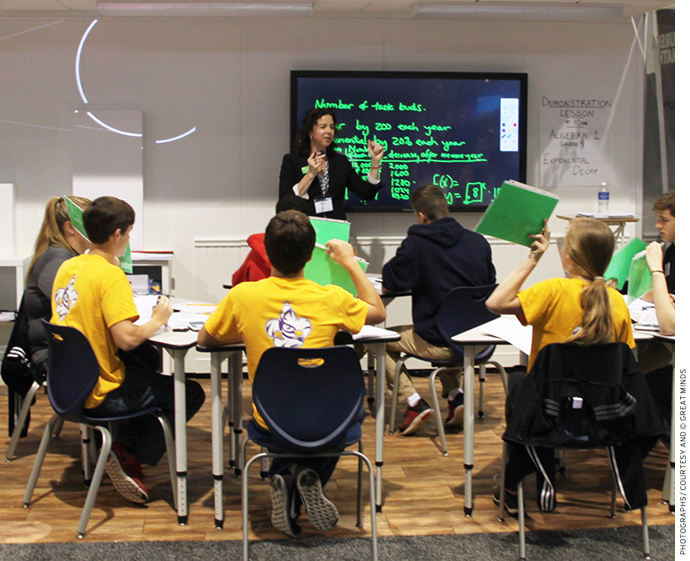
One of the most ambitious educational improvement projects in recent years was the adoption of new, more rigorous college- and career-ready academic standards by more than 40 U.S. states. Though the Common Core label has suffered greatly from a populist backlash (see “Common Core Brand Taints Opinion on Standards,” features, Winter 2017), the reports of its death have been greatly exaggerated. The standards themselves remain largely intact, even in states that have renamed and tweaked them. The aligned PARCC and Smarter Balanced tests are also still in place in more than half of the states that adopted them. Despite the controversy, most U.S. states have raised the bar for what it means for students to be on track for success (see “After Common Core, States Set Rigorous Standards,” features, Summer 2016).
That’s all well and good, but what really matters is whether higher standards and tougher tests lead to positive changes in the classroom. And this is where there is still a ton of important, if unsexy, work to be done. As late as October 2016—more than six years after the first wave of states adopted the standards—fewer than one in five teachers said their instructional materials were well aligned to the Common Core, according to a national Education Week survey.
That’s a problem. A growing body of evidence indicates that the choice of a strong, aligned curriculum can have outsized impacts on student learning. In a 2012 review, Matthew Chingos and Grover Whitehurst found “strong evidence that the choice of instructional materials has large effects on student learning—effects that rival in size those that are associated with differences in teacher effectiveness.” A recent study by Cory Koedel and Morgan Polikoff of California math textbooks found similar effects.
The fast-moving adoption of Common Core was an unprecedented disruption to a curriculum and textbook market that’s long been dominated by a few major publishers. This is an area where reformers and foundations could make a big difference, by helping put new, high-quality instructional materials into teachers’ hands. This won’t require passing any new laws or enacting additional regulations. But it will take leadership and the willingness to support entrepreneurs working to develop resources that can address teachers’ needs. The story of Eureka Math offers hope, and something of a roadmap.
Eureka Math—and Great Minds, the nonprofit organization that created it—is the David to Pearson’s Goliath. Great Minds didn’t even exist 10 years ago, and only went into the curriculum-development business when it won a contract from New York State to build a set of free, online math lessons as part of the state’s Race to the Top (RTT) grant. The resulting curriculum, originally known as “EngageNY,” spread rapidly nationwide, and a 2015 RAND survey found that an astonishing 44 percent of elementary school teachers in Common Core states reported using EngageNY at least once a week, more than any other math program, and 13 percent said they used Eureka Math.

Great Minds’ pitch is that teachers and scholars specifically designed Eureka Math in response to the new standards, and the nonprofit curriculum reviewer EdReports.org has found it is well aligned. Unlike some other popular programs, Eureka Math doesn’t overlook the need to develop students’ fluency with mathematical procedures, especially in the early years. Elementary students are expected to know their addition and multiplication facts, for example, and practice them frequently. Another RAND analysis found that Eureka Math is particularly popular in Louisiana—where state officials strongly recommend its use—and speculated that it might help to explain the state’s impressive achievement gains of late.
On the surface, the lesson seems simple: if you build a great curriculum and make it available for free on the Internet, teachers will flock to it. That’s certainly what I heard from the organization’s president, Lynne Munson. “What we create are knowledge-rich instructional materials that are worthy of study,” she said. “Not scripts, but lessons that will reward teachers’ close reading and collaboration.”
To be sure, Great Minds holds high expectations for what teachers are capable of, and teachers have rewarded it with their enthusiasm for its curriculum. But crucially, its materials are of high quality, in part because its start-up budget was considerable: $14 million in federal RTT funds. Quality is easier to achieve with that kind of backing.
But why is Eureka Math so popular when other resources go begging for users? Eureka Math is hardly the first or only open educational resources (OER) available on the web. Nor is it the case that nobody has ever built a solid math program before. And its competition includes huge textbook companies with well-established distribution channels, including hundreds of former school superintendents buying steak dinners for their pals and getting them to purchase the latest series. What explains the program’s meteoric rise and continental reach?
Ironically, its success may be due in part to the fact that it isn’t entirely free. One source I spoke to said that part of Eureka’s genius was that it “filled the beast’s need to procure.”
While anyone can download the math modules from EngageNY, the OER version is available only via clumsy PDFs. To get an easier-to-use online interface, plus a rich library of training videos, schools need to purchase a subscription from Great Minds. And even then, most want print materials, plus professional development, which the organization also offers—for a fee.
And guess what? Schools are willing to pay. District administrators and procurement officers have budgets for materials and feel strange about not using them. The OER version gave them a low-risk way to try out the curriculum; the paid version gave them something to buy. This revenue stream has also allowed Great Minds to build out a network of regional sales representatives, though Munson says her people are busy simply responding to inquiries from educators: “we don’t cold call anyone, ever.” She said that interest
in the program has grown organically, from word of mouth, from the “free advertising” provided by EngageNY, and from the positive reviews by EdReports.org and others.
The Great Minds story should serve as an example of what comes next. Anyone interested in helping teachers and students innovate and meet new standards should support this type of marriage of top-down funding and bottom-up design. Those of us in education reform have a bad habit of not finishing what we started, of chasing a new shiny idea every few years. Doubling down on curriculum reform is one important way to get the Common Core job done. Who’s in?
Michael J. Petrilli is president of the Thomas B. Fordham Institute and executive editor at Education Next.
This article appeared in the Summer 2017 issue of Education Next. Suggested citation format:
Petrilli, M.J. (2017). A Common Core Curriculum Quandary: For Eureka Math, open-source leads to a revenue stream. Education Next, 17(3), 83-84.


